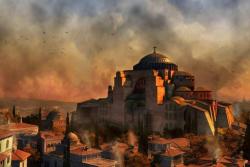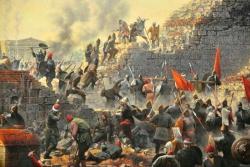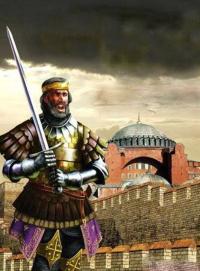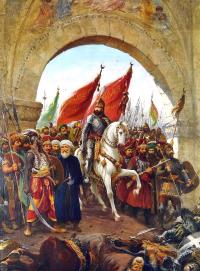Fall of Constantinople
 The Fall of Constantinople occured on Tuesday 29th May 1453, after a 53 day seige which began on 6th April by the Ottoman Sultan Mehmed II. Constantinople was representing the failing Byzantine Empire, led by the Emperor Constantine XI Palaiologos. A beacon of Christian and Hellenic culture for over 1100 years, now reduced to a small region around the city as well as a part of the Peloponnese, based around Mystras. After cutting off Constantinople from the Black Sea and any potential aid that might be received from Geonese colonies in the region, Mehmed II tightened the noose around the great city. Constantine XI appealed to Pope Nicholas V for aid, and despite centuries of animosity between the Orthodox and Latin churches, the Pope finally agreed to seek help in the West.
The Fall of Constantinople occured on Tuesday 29th May 1453, after a 53 day seige which began on 6th April by the Ottoman Sultan Mehmed II. Constantinople was representing the failing Byzantine Empire, led by the Emperor Constantine XI Palaiologos. A beacon of Christian and Hellenic culture for over 1100 years, now reduced to a small region around the city as well as a part of the Peloponnese, based around Mystras. After cutting off Constantinople from the Black Sea and any potential aid that might be received from Geonese colonies in the region, Mehmed II tightened the noose around the great city. Constantine XI appealed to Pope Nicholas V for aid, and despite centuries of animosity between the Orthodox and Latin churches, the Pope finally agreed to seek help in the West.
The Pope's efforts proved fruitless, as many of the Western nations were engaged in their own wars and conflicts so could not spare men or money to aid Constantinople. A few reinforcements had managed to get through in January, including Giovanni Giustiniani who arrived with 700 men from Genoa and Chios. This brought the city defenders strengh to around 7,000 men, facing a much larger Ottoman force of between 50,000 and 80,000 soldiers. As a specialist in defending walled cities, Giustiniani was immediately given overall command of the land walls by the Emperor. However, unlike previous sieges of Constantinople, the surrounding Ottoman army brought gunpowder and large cannon with them. The city began to despair as word was received that no further aid would be coming from Venice, Rome or Europe. In addition, a series of dark omens including a thick, unexpected fog which blanketed the city on 26th May, convinced many defenders that the city was about to fall. As initial assaults against the massive Theodosian Walls had repeatedly failed and frustrated any significant progress, Sultan Mehmed II called a council of war. He decided that after a short period of rest and prayer, a massive final assault would be launched just before midnight of 28th May.
 Having achieved some initial success, the vast Ottoman army was held by Byzantine forces under Giustiniani until he was badly wounded. As their commander was taken to the rear, the defence began to collapse. To the South, Emperor Constantine led forces defending the walls in the Lycus Valley, under heavy pressure, his position began to collapse when the Ottomans found that the Kerkoporta postern gate had been left open. With the enemy surging through the gate, Constantine XI was forced to fall back. Though his exact fate is not known, it is believed that Constantine XI was killed in a last desperate attack against the enemy. As the Ottoman forces began to make their way through the city, Mehmed assigned men to protect key buildings, although he allowed his army to plunder its riches for 3 days.
Having achieved some initial success, the vast Ottoman army was held by Byzantine forces under Giustiniani until he was badly wounded. As their commander was taken to the rear, the defence began to collapse. To the South, Emperor Constantine led forces defending the walls in the Lycus Valley, under heavy pressure, his position began to collapse when the Ottomans found that the Kerkoporta postern gate had been left open. With the enemy surging through the gate, Constantine XI was forced to fall back. Though his exact fate is not known, it is believed that Constantine XI was killed in a last desperate attack against the enemy. As the Ottoman forces began to make their way through the city, Mehmed assigned men to protect key buildings, although he allowed his army to plunder its riches for 3 days.
Some defenders did manage to escape before the city was taken before midday. A Venetian captain ordered his men to break open the gate of the Golden Horn and managed to sail away in ships filled with soldiers and refugees. Shortly after, a few Genoese ships and even the Emperor's ships followed them out of the Golden Horn, narrowly escaping before the Ottoman fleet assumed control. However, within the city, there was widespread persecution of the civilian inhabitants, resulting in thousands of people being raped and murdered, particularly the faithful who had sheltered in the sacred church of Hagia Sophia, praying for divine intervention. The majority of the citizens of Constantinople, up to 45,000, were chained up and forced into slavery. The Holy Hagia Sophia was then turned into a Muslim mosque. For Sultan Mehmed II, the capture of Constantinople earned him the title of el-Fātiḥ 'The Conqueror' and provided him with a base for campaigns into Europe. A major turning point in Western history, the Fall of Constantinople saw the end of the Byzantine Empire, the end of the Middle Ages and the beginning of the Renaissance.



Throughout the many centuries of its existence, all Greeks had referred to Constantinople simply as Polis (City). When one was going to the Polis, they would say 'Is tin Poli', a phrase which morphed into the modern term Istanbul. The great city was called Constantinople by the entire wider world until the 20th Century. Although the Ottomans had unofficially called it Istanbul for years, the official name change of its largest city only took place in 1930, after the establishment of the new modern Republic of Turkey.